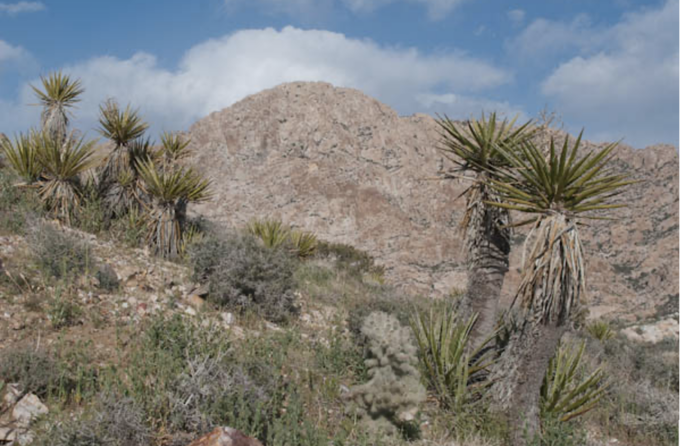
The granite summit of Spirit Mountain in the Spirit Mountain Wilderness. Photo George Wuerthner.
President Biden appears ready to designate the Avi Kwa Ame National Monument in southern Nevada.
The monument will protect almost a half million acres of the Mohave Desert between the California border and the Colorado River. Stretching from the Newberry mountains in the east to the New York, South McCullough, Castle, and Piute mountains in the west, the monument encompasses representative landscapes of grasslands, Joshua trees, and in places, even scrub oak. Wildlife native to the area includes desert bighorn sheep, Gila monster, and desert tortoises,
It would connect other protected landscapes in California, such as Mohave Trails National Monument and Mohave National Preserve, with the Lake Mead National Recreation Area in Nevada, creating a corridor for wildlife to move more freely across the landscape. The area within the proposed monument also includes and/or borders several designated southern Nevada wildernesses, including Spirit Mountain, Nellis Wash, Wee Thump Joshua Tree, Bridge Canyon, Ireteba Peaks, and South McCullough wilderness areas.

At a meeting in Washington DC, tribal leaders Biden said he intended to designate a 450,000-acre national monument. The monument has the support of numerous local tribes, politicians, community leaders, and conservation groups.
The area is an essential cultural region to numerous tribes from the region, and the Fort Yuma tribe was able to get Avi Kwa Ame listed on the National Park Service’s National Register of Historic Places as a traditional cultural property in 1999. In addition, national Monument status would codify and expand the protection of the landscape.
Ten Yuman-speaking tribes across the Colorado River Basin, including the Mojave, Hualapai, Yavapai, Havasupai, Quechan, Maricopa, Pai Pai, Halchidhoma, Cocopah, and Kumeyaay, support the monument designation.
The Clark County Commissioners unanimously supported the designation of a national monument. In addition, small communities near the proposed monument, including Boulder City Council, the Searchlight Town Advisory Board, and the Laughlin Town Advisory Board, have all approved resolutions supporting the designation.
Representative Dina Titus, Democrat of Nevada, introduced a resolution in February to establish Avi Kthe Kwa Ame as a national monument.
With such broad support, one would hope that Biden would act to establish the national monument.
With increasing inappropriate solar development on federal lands (all solar should be done on rooftops and previously degraded lands like alfalfa fields), the designation of the Avi Kwa Ame NM could ensure that such development is not implemented in this area.
The federal government currently has identified millions of acres of public lands in Nevada for potential large-scale energy development, including 9 million for large-scale solar development and nearly 16.8 million for possible wind development.
To put this into perspective, the combined 25.8 million acres open for “green” development is larger than the entire state of Maine. Biden could do more to preclude such development on public lands. There is more than enough private land, especially existing Ag lands like irrigated hay/alfalfa fields, that could be converted to such energy production without the necessity of degrading existing public lands so critical to biodiversity and ecosystem function.
National Monuments can be established by Presidential decree. But, so far, Biden is lagging well behind other presidents in the acreage and number of national monuments he has created. Although he restored the original boundaries of Bears Ears and Grand Staircase Escalante national monuments in Utah and created Camp Hale NM in Colorado, other Presidents have done considerably more to preserve America’s wildlands. President Obama, for instance, designated 38 national monuments during this presidency.
It is unclear yet which federal agency might administer an Avi Kwa Ame National Monument. Still, the National Park Service is the best candidate since they have a mission more aligned with the monument’s biodiversity and cultural preservation goals.
It is hoped that the designation of Avi Kwa Ame as a national monument will be only the beginning of his administration’s commitment to protecting 30 percent of the US land and waters by 2030.